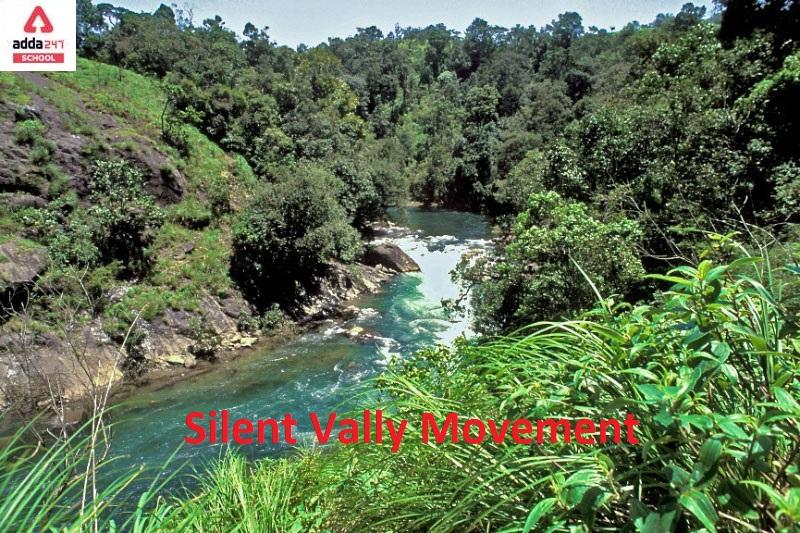Silent valley is an evergreen tropical forest, which is a densely forested area in the Palakkad district of Kerela, India. The silent valley movement was started in 1978, by an NGO in Kerala named Kerala Sasthra Sathiya. The movement started as a Wildlife conservation project.
Silent Valley Movement
The silent valley has a mythological history which we will see further in the article. Here in this article, we will discuss the silent valley movement’s, history, origination, and conservation of the silent valley movement. This article is useful for competitive exams like UPSC, this can come under basic general knowledge. To more keep reading.
Silent Valley Movement Leader Name
The Silent Valley Movement, which took place in the 1970s in Kerala, India, silent valley movement was initiated by environmentalist Sugathakumari. She, along with other activists and organizations, worked to protect the Silent Valley, a unique tropical rainforest, from being submerged due to a proposed hydroelectric project on the Kunthipuzha River. The movement ultimately led to the declaration of Silent Valley as a National Park in 1984, preserving its rich biodiversity.
Silent Valley Movement Took place in India
Silent valley is famous for the rare species of animals and birds found there. The forest is densely forested and has deep forests, this causes no noise in the forest except the birds and insects, this is the reason this Valley is Known as Silent valley. The area of this Valley is 90 square kilometers. The river Kunthipura across Silent valley. The river covers about 15 km and it originates from a height of 2400 m. The silent valley has a mythological history which says that the Pandavas after they lost their kingdom and property, settled in the silent valley. The silent valley movement originated after the announcement of dam construction at the upper stream of Kunthipura. The state government conducted its first survey in 1958. The British technical experts suggested that the dam at the upper stream can help in generating hydroelectricity. The project was approved in 1973 by the planning commission. The main objective of the project was to generate 120 megawatts of electricity and water to produce 240 megawatts of electricity. There was no such protest till 1976. In 1976, a group of environmentalists came forward to protect against the construction of a dam over the upper stream. Under the president of Vice-president of World wildlife Find, India, a task force was formed. The task force worked for a year and did several surveys, which suggested stopping the construction of the project. The report presented by the task force concluded that the construction of the project will cause a lot of damage to forest life and will lead to disasters in the forest. It will ultimately harm the flora, fauna, and water. The report also suggested that if the government has no option but to build the dam, they have to follow the 17 guidelines provided by the report. In 1979, the lead of the task force accepted that the earlier report was his mistake and he plead with the government for a total ban on the project.
Silent Valley Movement: Effects
Kerela Sasthra Sathiya Parishad (KSSP), an NGO and the largest popular science organization in Kerala started the silent valley movement. The state conference accepted the proposal of banning the project and KSSP launched a huge signature campaign to stop the construction of the project. The project was then endorsed in the legislative assembly. KSSP launched a booklet named “The silent valley movement Hydroelectric project- A techno-economic and socio-political assessment”. In 1979, the then prime minister of India ordered the state government to cancel the project.
Silent Valley Movement Short Note
The silent valley was declared a reserve forest after the silent valley movement. In 1983, the government banned all the forest activities and declared it a national park. In 1986, the silent valley was declared the core area of the Nilgiri Biosphere Reserve. The constant efforts of KSSP led to the successful completion of the silent valley movement and it conserved the evergreen tropical forest. The rare species of wildlife is still going in the heart of the Silent valley.
Mouna Kanive Andolan in Kannada
ಮೌನ ಕಣಿವೆ ಆಂದೋಲನ (Mouna Kanive Andolana) Karnataka’s historically significant Mouna Kanive Andolana is a protest movement by farmers demanding their fair share of water from the Upper Krishna Project (UKP). Here are the details in Kannada:
ಮೌನ ಕಣಿವೆ ಆಂದೋಲನದ ಹಿನ್ನೆಲೆ:
ಮೌನ ಕಣಿವೆ ಆಂದೋಲನವು ಕರ್ನಾಟಕದ ಕೃಷಿಕರ ಹಕ್ಕುಗಳಿಗಾಗಿ ನಡೆದ ಮಹತ್ವದ ಪ್ರತಿಭಟನೆಯಾಗಿದೆ. ಇದನ್ನು ನಿಜವಾದ ‘ಮೌನ ಪ್ರತಿಭಟನೆಯ’ ರೀತಿಯಲ್ಲಿ ನಡೆಸಲಾಯಿತು, ಈ ಆಂದೋಲನದಲ್ಲಿ ರೈತರು ಸುಮ್ಮನೆ ಕುಳಿತುಕೊಳ್ಳುವುದರ ಮೂಲಕ ತಮ್ಮ ಆಕ್ರೋಶವನ್ನು ವ್ಯಕ್ತಪಡಿಸಿದರು. ಮುಖಾಮುಖಿಯಾಗಿ ಮಾತನಾಡದೇ, ನೀರಿನ ಸಮಾನ ಹಂಚಿಕೆಗಾಗಿ ಇವರ ಈ ಮೌನವೇ ಆಂದೋಲನದ ಪ್ರಮುಖ ಮಾಧ್ಯಮವಾಯಿತು.
ಆಂದೋಲನದ ಉದ್ದೇಶ:
ಇದು ಮುಖ್ಯವಾಗಿ ಕೃಷ್ಣಾ ನದಿಯ ನೀರಿನ ಸಮಾನ ಹಂಚಿಕೆಗಾಗಿ ಮಾಡಲಾದ ಆಂದೋಲನವಾಗಿದೆ. ಮೌಲಿಕವಾಗಿ ಕೃಷ್ಣಾ ಮೇಲ್ದಂಡೆ ಯೋಜನೆಯಡಿ ಬರಬೇಕಾದ ನೀರನ್ನು ಭೀಮಾ ನದಿಪಾತ್ರದ ರೈತರು ತಮ್ಮ ಕ್ಷೇತ್ರಗಳಿಗೆ ಸಿಗುವಂತೆ ಒತ್ತಾಯಿಸಿದರು. ಈ ಆಂದೋಲನದ ಅಡಿಯಲ್ಲಿ ರೈತರು ತಮ್ಮ ಹಕ್ಕುಗಳಿಗಾಗಿ ಎಷ್ಟು ನಿಶ್ಚಲ, ಶಾಂತ ಮತ್ತು ಸಮರ್ಥವಾಗಿರಬಹುದು ಎಂಬುದಕ್ಕೆ ಉದಾಹರಣೆ ನೀಡಿದರು.
ಆಂದೋಲನದ ಪ್ರಭಾವ:
ಮೌನ ಕಣಿವೆ ಆಂದೋಲನದಿಂದ ಸರ್ಕಾರದ ಗಮನ ಇದಕ್ಕೆ ಸೆಳೆಯಿತು. ಈ ಆಂದೋಲನದಲ್ಲಿ ರೈತರು ಸಂಘಟಿತವಾಗಿ ಭಾಗವಹಿಸಿದ್ರು, ತಮ್ಮ ಬೇಡಿಕೆಗಳನ್ನು ಸರ್ಕಾರಕ್ಕೆ ತಲುಪಿಸಲು ಯಶಸ್ವಿಯಾದರು.









 RRBMU Result 2025 OUT, Get Matsya Univer...
RRBMU Result 2025 OUT, Get Matsya Univer...
 Best CUET Coaching in Delhi: Reasons to ...
Best CUET Coaching in Delhi: Reasons to ...
 Best CUET Coaching in Noida- Know Locati...
Best CUET Coaching in Noida- Know Locati...










